Abstract
Smart cities are widely regarded as a promising solution to urbanization challenges; however, environmental aspects such as outdoor thermal comfort and urban heat island are often less addressed than social and economic dimensions of sustainability. To address this gap, we developed and evaluated an affordable, scalable, and cost-effective weather station platform, consisting of a centralized server and portable edge devices to facilitate urban heat island and outdoor thermal comfort studies. This edge device is designed in accordance with the ISO 7726 (1998) standards and further enhanced with a positioning system. The device can regularly log parameters such as air temperature, relative humidity, globe temperature, wind speed, and geographical coordinates. Strategic selection of components allowed for a low-cost device that can perform data manipulation, pre-processing, store the data, and exchange data with a centralized server via the internet. The centralized server facilitates scalability, processing, storage, and live monitoring of data acquisition processes. The edge devices’ electrical and shielding design was evaluated against a commercial weather station, showing Mean Absolute Error and Root Mean Square Error values of 0.1 and 0.33, respectively, for air temperature. Further, empirical test campaigns were conducted under two scenarios: “stop-and-go” and “on-the-move”. These tests provided an insight into transition and response times required for urban heat island and thermal comfort studies, and evaluated the platform’s overall performance, validating it for nuanced human-scale thermal comfort, urban heat island, and bio-meteorological studies.
1. Introduction
The rapid increase in the global urban population to 68% in 2050 [1] has led to the smart city concept as a solution for addressing urbanization challenges, such as population growth, pollution, scarcity of water, energy efficiency, etc. According to the International Institute for Management Development (IMD) Smart City Index 2024, there are 142 smart cities worldwide [2]. The main aim of smart cities is to deliver a better quality of life through better decision-making using technology, and it is categorized into Information and Communication Technology (ICT) and a people-oriented approach [3]. Holistically, smart cities can be understood as the combination of technology, government, and society for a smart economy, smart mobility, smart environment, smart people, smart living, and smart governance [3].
Among various smart city applications, sensors placed in plants contribute towards future food security through precision agriculture. Cloud-connected sensors present in waste bins, health trackers, homes, urban infrastructure, and vehicles help in efficient and sustainable waste collection, real-time health monitoring, efficient energy use in homes, checking the structural stability and governance of various urban infrastructures, and also address traffic problems and congestion in the city [4]. Smart cities can be understood as the use of sensors for data collection, transmission/reception of the collected data through Wireless Fidelity (Wi-Fi), Cellular, Long Range (LoRa), Zigbee, Bluetooth, Bluetooth Low Energy (BLE), and Sigfox, among other possible data communication technologies, the storage of this data in the cloud and using it for analysis [4,5,6]. More information and a comparison of the mentioned communication technologies can be found in [4]. However, the smart city framework has weakly considered the environmental aspects as opposed to the social and economic aspects of urban sustainability [3]. In particular, technologies measuring Urban Heat Islands (UHI) and outdoor thermal comfort are weakly studied in comparison to other urban environmental problems, such as air quality, water, and energy [7].
UHI is a phenomenon where cities are warmer compared to the surrounding rural areas [8]. The cities in the UK can get warmer by up to 8 °C to 10 °C compared to the surrounding rural areas [9]. Given the circumstances of frequent heat waves globally, UHI is an imminent threat to human life, plant and animal species, water quality, etc. Even a 1 °C increase in temperature demands 2 to 4% more energy for air-conditioning and refrigeration, which directly impacts the cost of living [10,11,12,13]. Therefore, to integrate and increase smart cities’ interest in environmental issues, especially UHI and outdoor thermal comfort, this research aims to build an Internet of Things (IoT)-based low-cost smart weather station platform with a portable weather sensor device and a centralized server to facilitate real-time data collection, monitoring, and atmospheric data storage for understanding heat stress in urban areas.
The Array of Things (AoT), a fixed wireless sensor network distributed across urban areas, is one of the methods used to record and monitor real-time temperature across the city. The cities of Chicago and Seoul in South Korea used a network of 130 and 1100 fixed wireless sensors, respectively, for real-time temperature monitoring and analysis through IoT [14,15,16]. However, capturing the human scale UHI and thermal comfort requires fine spatial scale temperature and other atmospheric variables measurements (wind speed, wind direction, Mean Radiant Temperature, etc.). This will help architects, urban designers, and landscape architects in developing thermally comfortable and climate-responsive designs [17]. However, this is impractical and not cost-effective with fixed sensors, as it requires more sensor units in a short spatial distance. Unlike the AoT (typically mounted to the lamp posts or other street furniture), wireless smart sensors used in mobile weather stations have facilitated high spatial-resolution data collection as they allow measuring atmospheric variables at locations of particular interest (such as in front of a shop, or a residential building, etc.). Since a mobile weather station consists of only one set of smart sensors to measure various atmospheric variables, they are considered cost-effective and sustainable compared to a fixed wireless sensor network with hundreds or thousands of sensor units. Among the mobile weather stations, the non-motorized (bicycle, cart, walking) weather stations can even measure the atmospheric variables in pedestrian pathways and cycleways in the city, facilitating a finer spatial scale compared to motorized (car, motorbike, bus, train, etc.) weather stations [18].
For any thermal comfort study, Air Temperature (AT), Relative Humidity (RH), Wind Speed (WS), and Mean Radiant Temperature (MRT) are the four variables that need to be measured. Among these four variables, MRT is not directly measured but is calculated using short-wave and long-wave radiation measurements obtained from pyranometers and pyrgeometers, respectively, which are positioned in six orthogonal directions (up-down, north-south, east-west) or calculated using Globe Temperature (GT) measurements. GT is an integrated temperature value of dry-bulb temperature, air movement, and net radiant heat received from the surrounding surface [19]. Therefore, in [20,21,22,23] authors took advantage of pyranometers to record short-wave radiation measurements in addition to AT, RH, and WS. Whereas, in [24,25], authors also measured both the short-wave and long-wave radiation to accurately obain the MRT using pyranometers and pyrgeometers, respectivelyHowever, this approach is less cost-efficient compared to GT as pyranometers and pyrgeometers are relatively much more expensive [26].
In [27,28], AT and RH were only measured, whereas [29,30,31,32,33] also included WS. These studies used commercially available portable sensor devices, HOBO data loggers and sensors [27,28,29,33]; Kestrel 5500 [30]; KX-5 ultrasonic weather station [31]; and ZK-YD6A and TESTO405-V1 hand-held heat-sensitive anemometers [32]. An external data logger was also used by the studies to connect and acquire data from the sensors [29]. The studies [21,34,35,36,37,38,39,40,41,42,43] also measured GT along with the other three variables for calculating MRT. They used two sensor devices, as the commercially available portable sensor devices do not facilitate GT measurements: the first device to measure AT, RH, and WS, and the second device with an AT sensor customized for GT measurements. Even though some of these devices support IoT integration for real-time monitoring, the absence of sensors to measure GT makes them unfit for outdoor thermal comfort studies. Additionally, ultrasonic wind sensors for measuring wind speed and direction are expensive (£849 to £1393), though precise, compared to cup anemometers (£30 to £50).
Johansson et al. [26] suggest a 40 mm flat grey globe thermometer for GT measurement. Authors proposed a temperature sensor inside a table tennis ball painted with RAL 7001 (flat grey) color, as it provides accurate results according to ISO 7726 (1998) [44] and the ASHRAE handbook of fundamentals. The 150 mm diameter copper globe thermometers have large time constants and are not recommended for outdoor thermal comfort studies [26]. Commercial products to measure GT include the WBGT-2010SD heat stress meter with a 75 mm black globe [42]; TM-188 heat stress meter with a 50 mm brass black [37]; and TP3275 globe thermometer, which has a Pt100 temperature sensor inside a 150 mm black globe [39]. A a 150 mm diameter globe, a 25 mm diameter black globe calibrated to achieve the standard of a 150 mm diameter globe, and a 75 mm diameter black globe, respectively are used in [35,40,45]. Alternatively, Yang et.al. [34] customized the globe according to ISO 7726 (1998) and the ASHRAE handbook of fundamentals for GT measurements using S-TMB-M002 HOBO and Pt100 temperature sensors, respectively.
Therefore, the proposed weather device offers the following advantages over the existing literature:
- Portability: It is a battery-operated mobile device measuring 50 cm × 11 cm × 20 cm and weighing about 750 g.
- Cost-efficient: The proposed weather station costs about £80 per edge device, compared to the commercially available Davis Vantage Pro 2, which is priced at £995.
- Scalability: Theoretically, unlimited edge devices can be added to the system.
- Real-time remote monitoring: All edge devices can be monitored through the webpage.
- Automatic location tagging: Integration of the Global Positioning System (GPS) allows automatic location tagging.
- Higher sampling time: The edge device provides a reading every 6 s.
- GT integration allows for MRT calculation: MRT is one of the main variables for thermal comfort studies.
Section 2 presents the design and development of the IoT edge device and the choice of sensors to meet the UHI and outdoor thermal comfort study requirements. Section 3 outlines the validation and performance of the edge device in terms of atmospheric variable measurements. Section 4 shows the test results of preliminary tests, followed by Section 5, the discussion, and conclusion.
2. Proposed Weather Station Platform
To overcome the existing challenges mentioned in the previous section for outdoor thermal comfort studies, we developed a weather station platform with an edge device for non-motorized weather observation in urban settings. In this section, we present the rationale behind the selection of various required sensors and their description.
2.1. Sensor Selection
Range, precision, accuracy, and response time of the sensors are the four factors that need to be taken care of while selecting a sensor for UHI/microclimate studies [26,46]. The international standard ISO 7726:1998 provides a framework for outdoor thermal comfort studies [26]. Based on this framework, we selected the sensors to develop the prototype of the edge device. Table 1 presents the selected sensors’ range, accuracy, precision, and cost, along with the ISO 7726:1998 requirements.

Table 1.
Range, accuracy, precision, and cost of the selected sensors to measure AT, GT, RH, and WS.
The edge device prototype used two MCP980 temperature sensors for AT and GT measurements. This sensor communicates its measurements over the Inter-Integrated Circuit (I2C) protocol. Although the DHT22 and similar sensors facilitate both AT and RH measurements, the MCP980 was selected for AT measurements due to its higher range, accuracy, and precision, meeting or exceeding the ISO 7726:1998 requirement. A second MCP980 was used to develop a globe thermometer for GT, following well-established methods in [26].
One DHT22 sensor, with an RH range of 0% to 99.9%, was used to measure RH using the I2C protocol.
One U-block NEO-7M GPS sensor was used to gather location information. This sensor provides latitude, longitude, altitude, and speed information, along with the measurement date and time.
One SEN0483 cup anemometer was used to measure wind speed. This sensor uses the Modbus protocol over the RS485 serial communication; therefore, a Universal Serial Bus (USB) to RS485 module was used to convert the RS485 to Universal Asynchronous Receiver-Transmitter (UART), to make it compatible with a broader range of microcontrollers. Apart from offering the full ISO 7726:1998 required range, this sensor is lightweight, affordable, and consumes less power than ultrasound and hot wire sensors.
2.2. Microcontroller Unit (MCU)
Authors in [47] used an Arduino microcontroller and added a Secure Digital (SD) card and Wi-Fi modules to their platform. However, we propose the Raspberry Pi Pico W MCU as it has built-in Wi-Fi and 2 MB of storage. This reduces overall cost and the integration and development complexity of the edge device. This MCU is power efficient, has a Dual-core ARM Cortex-M0+ Central Processing Unit (CPU), and has about 26 physical General-Purpose Input/Output (GPIO) pins.
2.3. Design Architecture
The platform comprises a portable edge device with an MCU, sensors, and a centralized remote server. The edge device collects sensor measurements, performs data pre-processing, and stores and communicates the collected data to the centralized server for further processing and storage. Pushing the live data to a centralized server also facilitates data storage requirements on each edge device, reducing the cost per unit.
The backend of the centralized server facilitates data ingestion and monitoring by accepting connections from multiple edge devices, receiving their data stream, and performing post-processing and storage. The frontend provides a web-based dashboard to monitor the live data stream from each edge device. This allows the edge devices to run headless, eliminating the need for a graphical user interface for real-time monitoring, further reducing the per-unit cost of the edge devices.
This two-tier architecture, consisting of edge devices and a centralized server, provides several key benefits, such as lightweight, cost and power-efficient edge devices, a scalable network of edge devices, and real-time remote monitoring.
Each edge device MCU coordinates between the sensors and collects and stores measurements. This data is transmitted via the Internet to the remote server using the Message Queuing Telemetry Transport (MQTT) protocol. Internet connectivity is achieved via the MCU’s built-in Wi-Fi, which connects to the operator’s phone hotspot. The phone effectively acts as a cellular gateway and a real-time frontend that displays the data being received by the centralized server.
The centralized server is virtualized and hosted on an AMD64-based architecture, a containerized open-source Eclipse Mosquitto [48] message broker and Node-RED [49] server, providing MQTT connectivity and a web-based user interface for live remote monitoring, respectively. The server is further protected by the free open-source pfSense Community edition firewall [50], which only allows MQTT and the Hypertext Transfer Protocol Secure (HTTPS) to reach the centralized server. Finally, a domain name was acquired from a free Dynamic Domain Name System (DDNS) provider, and Let’s Encrypt [51] and Certbot [52] were used to automate the process of encrypting server communications by obtaining and updating Secure Sockets Layer (SSL)/Transport Layer Security (TLS) certificates. Figure 1 illustrates the portable weather station (edge device), communication channels, and the real-time monitoring interface.
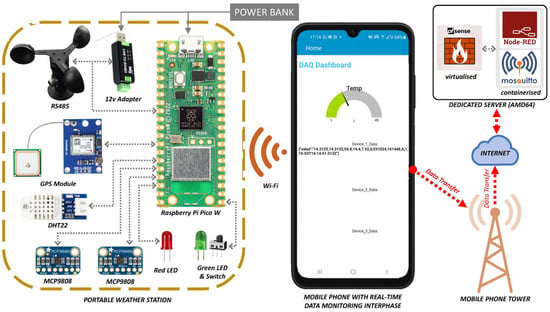
Figure 1.
The portable weather station device setup and real-time monitoring interface.
2.4. Housing and Shielding Design for the Edge Device
Shielding and ventilation of the sensors, especially temperature and humidity sensors, are very important to minimize measurement errors due to direct solar radiation, atmospheric radiation, wind, rain, fog, snow, dust, dirt, and pollutants. According to the World Meteorological Organization (WMO) guidelines, the standard weather shield for the sensors should be of low thermal absorption and high solar reflectance material, and the shield must allow air passage over the sensor [46]. Hence, housing and shielding designs for the AT sensor (see Figure 2) were explored for the edge device, and its performance was evaluated using Davis Vantage Pro 2.
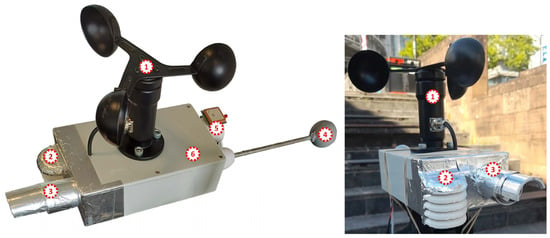
Figure 2.
(Left) image—Housing design (1—WS, 2—AT, 3—RH, 4—GT, 5—GPS antenna, 6—device housing). (Right) image—Shielding design of AT and RH (1—WS, 2—AT, 3—RH).
The housing design is a 190 mm × 57 mm × 114 mm plastic enclosure, with the anemometer screwed onto the enclosure lid. On the two shorter sides of the enclosure, the 114 mm sides, the AT, GT, RH sensors, and a GPS antenna were fixed. The RH sensor was kept inside a hollow pipe, with one end fixed to the box and the other open for air to pass over the sensor. The AT sensor was kept inside a semi-circular louvre, 3-D printed and painted white. A white color was chosen for the shields to minimize thermal absorption and was enclosed by aluminium foil for high solar reflection.
3. Validating the Edge Device
The weather variable readings provided by the prototyped weather station platform were compared with the Davis Vantage Pro 2 weather station to understand the proposed edge device’s accuracy and performance. For the same, the prototype and the Davis weather station were placed adjacent (within 1 m apart) in an outdoor environment at the same height. Six hours of continuous measurements were conducted between 13:00 and 19:00 using both the Davis Weather Station and the prototype. Mean Absolute Error (MAE) and Root Mean Square Error (RMSE) were calculated from these data sets to understand the prototype’s weather measurement accuracy. Table 2 presents the MAE and RMSE values.

Table 2.
MAE and RMSE values of the edge device against the Davis weather station.
Overall, the edge device performed well, with low MAE and RMSE numbers for all the measured variables. The 3-D printed semi-circular louvre was found to protect the AT sensor from direct solar radiation while providing good ventilation, as the absolute difference between the prototype and the Davis AT was only 0.1 °C. The MAE and RMSE values of the AT and WS were less than the sensors’ actual accuracy (according to the sensors’ respective datasheets). The RMSE of the RH sensor was only 0.04% higher than the sensor’s actual accuracy of ±2%.
4. Efficiency and Performance of the Proposed Weather Station Platform
This section discusses the five tests to assess the proposed platform’s performance. Mobile weather stations are used under two scenarios: ‘On the move’ and ‘Stop-and-go’ (i.e., the station was stopped at the intended locations for the measurements [8]). Therefore, we considered the same scenarios in our tests while mounting the edge device on a bike, as shown in Figure 3.
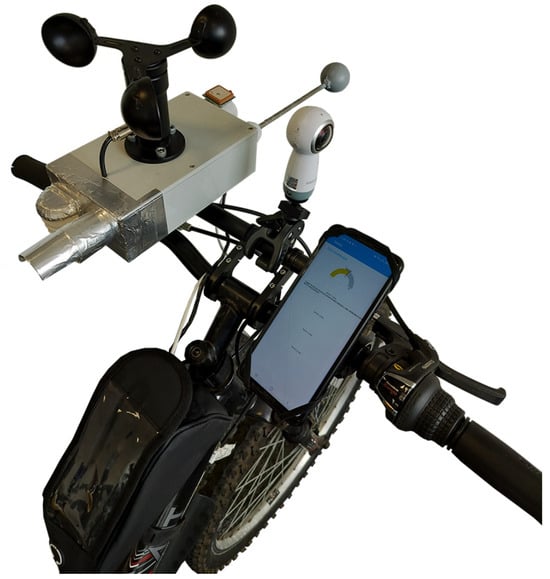
Figure 3.
The edge device is mounted on a bike for non-motorized mobile weather measurements.
The developed device depends on the cellular network to send the readings to the server. Therefore, two routes, A and B, were selected for the ‘on the move’ scenario (Figure 4). Route A presents an open area containing few or no buildings, while Route B presents a densely built city centre. For the ‘stop-and-go’ scenario, a few locations were chosen in a residential neighborhood where low-rise buildings are sparsely placed, and a few locations were chosen in a commercial neighborhood that is densely built with mid/high-rise buildings (see Figure 5). The chosen locations represent various street orientations and widths, surrounded by buildings and trees.
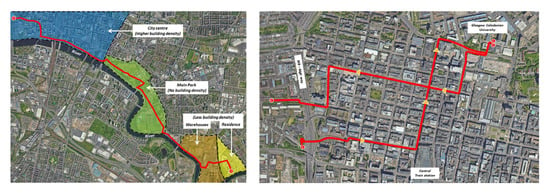
Figure 4.
‘On the move’ scenario: Route A (Left image) and Route B (Right image).
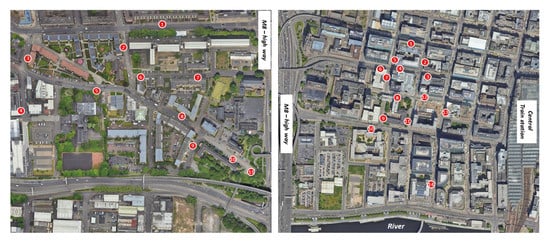
Figure 5.
‘Stop-and-go’ scenario: Residential neighborhood test locations (Left image) and Commercial neighborhood test location (Right image).
‘On the move’ scenario: Route A—Started from the residential neighborhood (Dalmarnock in Glasgow), moved to the neighboring streets with a warehouse (similar building density to Dalmarnock), and travelled along the River Clyde to Glasgow Green Park. The route continues through the park, with no buildings around, and entered Glasgow city centre via the riverside in the city centre. The collected data along this route were divided into five parts for a detailed analysis of the results, and these five parts are tabulated in Table 3.

Table 3.
Five geographical ‘On the move’ scenario Route A parts.
‘On the move’ scenario: Route B—Started from Glasgow Caledonian University (GCU), covers part of West Nile Street, moves on to Bath Street, reaches the M8 highway, takes the cycle and pedestrian pathway, and travels on Waterloo Street and Hope Street to return to the starting point.
‘Stop-and-go’ scenario: Residential and Commercial neighborhoods—Data at each fixed location, marked in Figure 5, were collected for about 10 min within 13:00 to 17:00 UTC hours. The device was not turned off until data collection was completed at all locations. The switch with the green Light-Emitting Diode (LED) in the device was used to tag the data collected at each specific location. Overall, the data was collected over two days: Day 1 for residential areas and Day 2 for commercial areas.
4.1. Test 1: GPS Module—Accuracy and Precision
The GPS sensor location readings (latitude and longitude) were analyzed by importing them into ‘my Google Maps’ and were overlapped with the actual location points. The distance between the actual location points and the GPS sensor values was measured to assess accuracy.
Figure 6 shows the result of the ‘On the Move’ scenario. Each red dot corresponds to a specific latitude and longitude value. Comparing it with the actual routes, Route A and Route B, the GPS sensor of the developed portable device accurately identified both Routes, irrespective of their built characteristics. However, the yellow dots (GPS sensor measurements) do not overlap with the red dot (actual location); see Figure 7 and Figure 8, especially in all the commercial neighborhood locations of the ‘Stop-and-Go’ scenario. Figure 7 and Figure 8 illustrate the typical behavior of the sensor readings in all the ‘Stop-and-Go’ locations.

Figure 6.
Location points are calculated using the latitude and longitude values provided by the GPS sensor. (Top) image—Route A and (Bottom) two images—Route B.

Figure 7.
Residential neighborhood locations. The images from left to right are locations 3, 6, and 11. The red dot on the image is the actual location of the device, the small yellow dots are the GPS sensor measurements, and the blue dot is the average of the yellow dots.

Figure 8.
Commercial neighborhood locations. The images from left to right are locations 1, 7, and 14. The red dot on the image is the actual location of the device, the small yellow dots are the GPS sensor measurements, and the blue dot is the average of the yellow dots.
Although the GPS sensor could capture the exact route of the ‘On the Move’ scenario, it struggled to capture the precise location within the street. Figure 9 shows the sensor’s inaccuracy within one of the routes of the ‘On the Move’ scenario. This might be due to building density, as some precise and accurate readings were noted in locations that have more openness. Another reason might be due to the Kalman filter or similar filters that are built within the sensor.
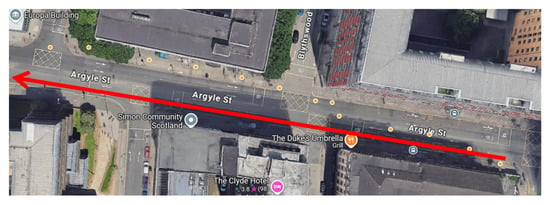
Figure 9.
Part of ‘On the Move’ Route A—with actual route (Red) and sensor values (yellow dots).
4.2. Test 2: Data Consistency
The total number of data points stored on the server and the device was cross-verified by calculating their differences.
Irrespective of the two scenarios and different built characteristics, no differences were found in the total number of collected data points stored in the device and the server, except for commercial location 4, with a negligible difference of 1 out of 103 data points. This server-side loss of data may be due to a poor internet connection. To overcome this issue in the future, a sequence number was added to the measurement for the automatic deduction of missing server data and to retrieve the same locally.
Overall, it can be concluded that the device can be used anywhere in Glasgow, as it is extremely consistent in saving data to the server, avoiding potential gaps in the data set.
4.3. Test 3: Latency/Timestamp Accuracy
To understand the delay in sending the measured values to the server, the difference between the server time and the time recorded by the GPS sensor was calculated (Server time minus GPS time). For this, only the data stored on the server was considered, as the data stored on the device does not have a server timestamp.
Table 4 shows the latency test results, with the mean, minimum, maximum, and standard deviation of the time difference in seconds. Overall, on average, it takes 2.5 to 2.9 s for data to reach the server, irrespective of the neighborhood building density in the ‘Stop-and-Go’ scenario. Even though the highest latency was 8.7 s, the standard deviation indicates that the latency is close to the mean. A similar average was noticed in Parts 4 and 5 and Route B of the ‘On the move’ scenario. On the other hand, a much lower average, between 1.0 and 1.5, was noticed in Parts 1, 2, and 3 of the ‘On the move’ scenario. This lesser latency might be due to the greater openness and the very few buildings in these locations compared to the other locations in both scenarios. As we have encountered a potential relationship between the urban setup and the latency, we suggest developing an optimization algorithm, similar to [53], by identifying the critical impacting factor and adjusting the data transmission accordingly.

Table 4.
Latency test results with minimum, maximum, mean, and standard deviation values for the selected location under the two scenarios.
4.4. Test 4: Data Sampling Rate
This section examines the time interval between two consecutive measurements using the server time.
Figure 10 illustrates the distribution of time intervals between consecutive data sets under two scenarios and across all chosen locations, showing the minimum, maximum, mean, and median values. Overall, irrespective of the scenario and location, the developed edge device prototype can measure data at an average interval of 5 to 7 s. The variations in the selected locations under the two scenarios might be due to changes in environmental conditions and variations in cellular reception.
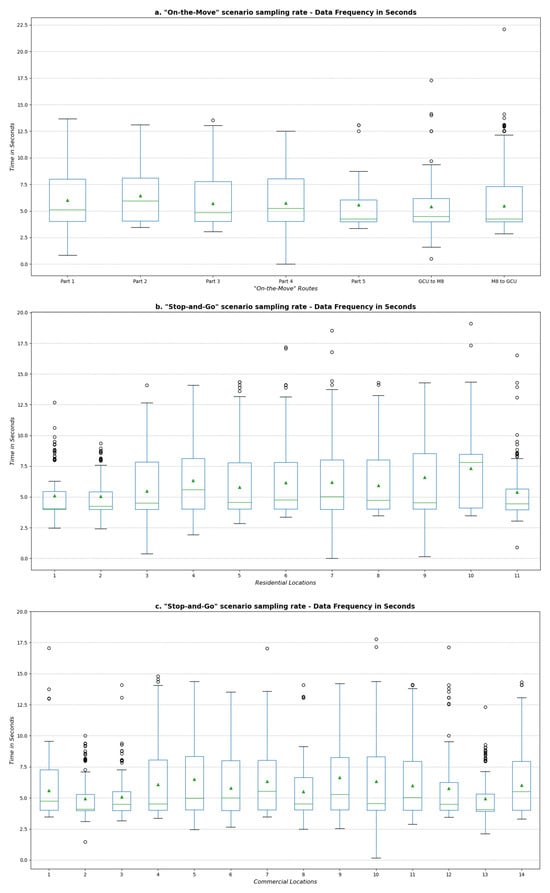
Figure 10.
Data sampling test results. The green horizontal line and green triangle represent median and mean values, respectively.
4.5. Test 5: Response Time
The response time refers to the time it takes for the sensor to react to a change in the measured environment and reach a new stable reading [46]. The AT, RH, and GT data collected during the ‘Stop-and-go’ scenario were used to assess the response time (see Figure 11).
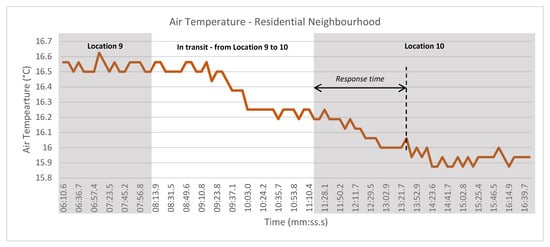
Figure 11.
An example of the ‘Stop-and-Go’ scenario response time calculation. This graph illustrates the partial air temperature values of locations 9 and 10 of the residential neighborhoods.
The response time results indicate that the device takes an average of 1.4 min to respond correctly to location changes. Out of 11 residential locations, the device’s response time was less than 1 min in 4 locations, less than or equal to 2 min in 4 locations, and 2.17, 3.51, and 5.35 min in the remaining three locations. Out of the 14 commercial locations, the device responded in less than or equal to 1 min in 5 locations, below 2 min in 3 locations, between 2 to 3 min in 2 locations, between 3 to 4 min in 3 locations, and slightly above 4 min in 1 location. Figure 12 illustrates the test results.
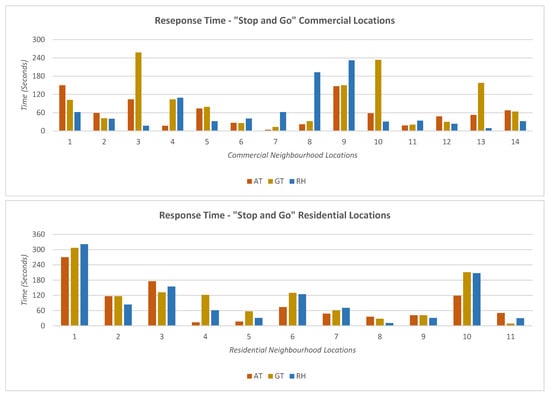
Figure 12.
Response time results.
5. Discussion and Conclusions
We successfully developed and tested a non-motorized weather station platform with a portable edge device to measure AT, RH, WS, and GT, and a centralized server. The centralized server accepts connections from multiple edge devices, receives the data stream, performs data processing, and stores it. Furthermore, we minimized the cost of the display screen, unlike [47], by developing a real-time data monitoring interface enabling data collection and real-time monitoring on any device, such as a mobile phone, laptop, or tablet with internet access, that was absent in [47,54]. We achieved higher atmospheric variable accuracy due to the use of appropriate shielding for sensors and adhered to the ISO 7726 (1998) standard and ASHRAE Handbook of Fundamentals for the GT, which were some limitations of [47]. Additionally, neither [54] nor [47] explored communication performance as we did in this paper, under various urban setups. During our tests, we also considered two scenarios in which the device would be used for thermal comfort and UHI studies.
Even though the GPS sensor correctly identified the routes taken to measure the atmospheric variables, it was found to be inaccurate within the street. This makes it a good fit for thermal comfort or UHI studies at the neighborhood level using the ‘on the Move’ method, but not for bio-meteorological, human-scale, or nuanced spatial-scale studies that focus on the street’s urban properties. However, this is not the case if a ‘Stop and Go’ method is used, as the interest points within the streets are predefined, thus making it not dependent on the GPS readings. Similarly, the delayed response leaves us with the question of how accurately the measured value can be associated with the appropriate location while performing the ‘On the Move’ observation.
Overall, there will be an interruption in the WS values due to the speed of the vehicle [8], the high response time of the sensor and the inaccuracy of the GPS module within the street make the device inadequate for nuanced human-scale thermal comfort/UHI studies or bio-meteorological studies using the ‘On the Move’ method. On the other hand, it is recommended to wait for 5 min to allow the device to respond to the location change in the ‘stop-and-go’ scenario before conducting the actual measurement.
Author Contributions
Conceptualization, R.S.B., S.H., F.S., R.E.; methodology, R.S.B., S.H.; Edge-device and interface development, S.H.; validation, R.S.B., S.H., F.S.; formal analysis, R.S.B.; investigation, R.S.B.; resources, R.E.; data curation, R.S.B.; writing—original draft preparation, R.S.B.; writing—review and editing, R.S.B., S.H., R.E; visualization, R.S.B.; supervision, F.S., S.H., C.S.T., R.E.; project administration, F.S., R.E.; funding acquisition, R.E. All authors have read and agreed to the published version of the manuscript.
Funding
This research received no external funding.
Data Availability Statement
Dataset available on request from the authors.
Conflicts of Interest
The authors declare no conflicts of interest.
References
- 68% of the World Population Projected to Live in Urban Areas by 2050, Says UN. Available online: https://www.un.org/development/desa/en/news/population/2018-revision-of-world-urbanization-prospects.html#:~:text=News-,68%25%20of%20the%20world%20population%20projected%20to%20live%20in,areas%20by%202050%2C%20says%20UN&text=Today%2C%2055%25%20of%20the%20world’s,increase%20to%2068%25%20by%202050 (accessed on 21 June 2024).
- IMD Business School for Management and Leadership Courses. Available online: https://www.imd.org/smart-city-observatory/home/ (accessed on 21 June 2024).
- Ahvenniemi, H.; Huovila, A.; Pinto-Seppä, I.; Airaksinen, M. What are the differences between sustainable and smart cities? Cities 2017, 60, 234–245. [Google Scholar] [CrossRef]
- Syed, A.S.; Sierra-Sosa, D.; Kumar, A.; Elmaghraby, A. IoT in Smart Cities: A Survey of Technologies, Practices and Challenges. Smart Cities 2021, 4, 475. [Google Scholar] [CrossRef]
- Hosseinzadeh, S.; Ashawa, M.; Owoh, N.; Larijani, H.; Curtis, K. Explainable Machine Learning for LoRaWAN Link Budget Analysis and Modeling. Sensors 2024, 24, 860. [Google Scholar] [CrossRef]
- Sanchez-Gomez, R.J.; Sanchez-Iborra, A. Transmission Technologies Comparison for IoT Communications in Smart-Cities. In Proceedings of the GLOBECOM 2017—2017 IEEE Global Communications Conference, Singapore, 4–8 December 2017; pp. 1–6. [Google Scholar]
- Smart Cities: Digital Solutions for a More Livable Future. Available online: https://www.mckinsey.com/capabilities/operations/our-insights/smart-cities-digital-solutions-for-a-more-livable-future (accessed on 21 June 2024).
- Oke, T.R.; Mills, G.; Christen, A.; Voogt, J.A. Urban Climates; Cambridge University Press: Cambridge, UK, 2017. [Google Scholar]
- Urban Heat Islands. Available online: https://www.rmets.org/metmatters/urban-heat-islands (accessed on 13 June 2024).
- Heatwave. Available online: https://wmo.int/topics/heatwave#:~:text=In%202022%2C%20a%20heatwave%20in,the%20country’s%20worst%20on%20record.&text=Devastating%20heatwaves%20in%20India%20and,likely%20due%20to%20climate%20change.&text=In%202022%2C%20heatwaves%20across%20the,record%20of%2038.7%C2%B0C (accessed on 14 June 2024).
- Ballester, J.; Quijal-Zamorano, M.; Méndez Turrubiates, R.F.; Pegenaute, F.; Herrmann, F.R.; Robine, J.M.; Basagaña, X.; Tonne, C.; Antó, J.M.; Achebak, H. Heat-related mortality in Europe during the summer of 2022. Nat. Med. 2023, 29, 1857. [Google Scholar] [CrossRef]
- Monsefi Parapari, D.; Taslim, S.; Shafaghat, A. Urban Design Guidelines to Mitigate Urban Heat Island (UHI) Effects in Hot-Dry Cities. J. Teknol. 2015, 74, 119–124. [Google Scholar]
- Lambert-Habib, M.L.; Hidalgo, J.; Fedele, C.; Lemonsu, A.; Bernard, C. How is climatic adaptation taken into account by legal tools? Introduction of water and vegetation by French town planning documents. Urban Clim. 2013, 4, 16–34. [Google Scholar] [CrossRef]
- Lyu, F.; Wang, S.; Han, S.Y.; Catlett, C.; Wang, S. An integrated cyberGIS and machine learning framework for fine-scale prediction of Urban Heat Island using satellite remote sensing and urban sensor network data. Urban Inform. 2022, 1, 6. [Google Scholar] [CrossRef]
- Kim, Y.; Jang, S.; Kim, K.B. Impact of urban microclimate on walking volume by street type and heat-vulnerable age groups: Seoul’s IoT sensor big data. Urban Clim. 2023, 51, 101658. [Google Scholar] [CrossRef]
- Jang, S.; Bae, J.; Kim, Y. Street-level urban heat island mitigation: Assessing the cooling effect of green infrastructure using urban IoT sensor big data. Sustain. Cities Soc. 2024, 100, 105007. [Google Scholar] [CrossRef]
- Middel, A.; AlKhaled, S.; Schneider, F.A.; Hagen, B.; Coseo, P. 50 Grades of Shade. Bull. Am. Meteorol. Soc. 2021, 102, E1805–E1820. [Google Scholar] [CrossRef]
- Kousis, I.; Manni, M.; Pisello, A.L. Environmental mobile monitoring of urban microclimates: A review. Renew. Sustain. Energy Rev. 2022, 169, 112847. [Google Scholar] [CrossRef]
- Roy Choudhury, A.K.; Majumdar, P.K.; Datta, C. 1—Factors affecting comfort: Human physiology and the role of clothing. In Improving Comfort in Clothing; Song, G., Ed.; Woodhead Publishing: Sawston, UK, 2011; pp. 3–60. [Google Scholar]
- Alchapar, N.L.; Correa, E.N. The use of reflective materials as a strategy for urban cooling in an arid “OASIS” city. Sustain. Cities Soc. 2016, 27, 1. [Google Scholar] [CrossRef]
- Ruiz, M.A.; Correa, E.N. Adaptive model for outdoor thermal comfort assessment in an Oasis city of arid climate. Build. Environ. 2014, 85, 40. [Google Scholar] [CrossRef]
- Kim, Y.J.; Brown, R.D. A multilevel approach for assessing the effects of microclimatic urban design on pedestrian thermal comfort: The High Line in New York. Build. Environ. 2021, 205, 108244. [Google Scholar] [CrossRef]
- Silva, T.; Reis, C.; Braz, D.; Vasconcelos, J.; Lopes, A. Climate walking and linear mixed model statistics for the seasonal outdoor thermophysiological comfort assessment in Lisbon. Urban Clim. 2024, 55, 101933. [Google Scholar] [CrossRef]
- Middel, A.; Krayenhoff, E.S. Micrometeorological determinants of pedestrian thermal exposure during record-breaking heat in Tempe, Arizona: Introducing the MaRTy observational platform. Sci. Total Environ. 2019, 687, 137. [Google Scholar] [CrossRef]
- Liu, S.; Nazarian, N.; Hart, M.A.; Niu, J.; Xie, Y.; De Dear, R. Dynamic thermal pleasure in outdoor environments—Temporal alliesthesia. Sci. Total Environ. 2021, 771, 144910. [Google Scholar] [CrossRef]
- Johansson, E.; Thorsson, S.; Emmanuel, R.; Krüger, E. Instruments and methods in outdoor thermal comfort studies—The need for standardization. Urban Clim. 2014, 10, 346. [Google Scholar] [CrossRef]
- Chen, Y.; Wang, Y.; Zhou, D.; Gu, Z.; Meng, X. Summer urban heat island mitigation strategy development for high-anthropogenic-heat-emission blocks. Sustain. Cities Soc. 2022, 87, 104197. [Google Scholar] [CrossRef]
- Shi, F.; Chen, Y.; Yue, W.; Wang, Y. High-Rise Residential District Morphology Optimization for Enhancing the Green Space Cooling Effect. Buildings 2024, 14, 183. [Google Scholar] [CrossRef]
- Brozovsky, J.; Corio, S.; Gaitani, N.; Gustavsen, A. Evaluation of sustainable strategies and design solutions at high-latitude urban settlements to enhance outdoor thermal comfort. Energy Build. 2021, 244, 111037. [Google Scholar] [CrossRef]
- Pan, W. What type of mixed-use and open? A critical environmental analysis of three neighborhood types in China and insights for sustainable urban planning. Landsc. Urban Plan. 2021, 216, 104221. [Google Scholar] [CrossRef]
- Fu, J.; Wang, Y.; Zhou, D.; Cao, S. Impact of Urban Park Design on Microclimate in Cold Regions using newly developped prediction method. Sustain. Cities Soc. 2022, 80, 103781. [Google Scholar] [CrossRef]
- Qi, L.; Liu, R.; Cui, Y.; Zhou, M.; Bonenberg, W.; Song, Z. Study of the Landscape Pattern of Shuiyu Village in Beijing, China: A Comprehensive Analysis of Adaptation to Local Microclimate. Sustainability 2022, 14, 375. [Google Scholar] [CrossRef]
- Hao, T.; Chang, H.; Liang, S.; Jones, P.; Chan, P.W.; Li, L.; Huang, J. Heat and park attendance: Evidence from “small data” and “big data” in Hong Kong. Build. Environ. 2023, 234, 110123. [Google Scholar] [CrossRef]
- Yang, F.; Qian, F.; Zhao, W. Towards a Climate-Responsive Vertical Pedestrian System: An Empirical Study on an Elevated Walkway in Shanghai China. Sustainability 2016, 8, 744. [Google Scholar] [CrossRef]
- Elnabawi, M.H.; Hamza, N.; Dudek, S. Thermal perception of outdoor urban spaces in the hot arid region of Cairo, Egypt. Sustain. Cities Soc. 2016, 22, 136. [Google Scholar] [CrossRef]
- Jin, H.; Cui, P.; Wong, N.H.; Ignatius, M. Assessing the Effects of Urban Morphology Parameters on Microclimate in Singapore to Control the Urban Heat Island Effect. Sustainability 2018, 10, 206. [Google Scholar] [CrossRef]
- Pan, W.; Du, J. Towards sustainable urban redevelopment: Urban design informed by morphological patterns and ecologies of informal settlements. Urban Ecol. 2020, 377, 377–411. [Google Scholar]
- He, B.; Ding, L.; Prasad, D. Relationships among local-scale urban morphology, urban ventilation, urban heat island and outdoor thermal comfort under sea breeze influence. Sustain. Cities Soc. 2020, 60, 102289. [Google Scholar] [CrossRef]
- Detommaso, M.; Costanzo, V.; Nocera, F. Application of weather data morphing for calibration of urban ENVI-met microclimate models. Results and critical issues. Urban Clim. 2021, 38, 100895. [Google Scholar] [CrossRef]
- Wei, D.; Yang, L.; Bao, Z.; Lu, Y.; Yang, H. Variations in outdoor thermal comfort in an urban park in the hot-summer and cold-winter region of China. Sustain. Cities Soc. 2022, 77, 103535. [Google Scholar] [CrossRef]
- Chen, L.; Mak, C.M.; Hang, J.; Dai, Y. Influence of elevated walkways on outdoor thermal comfort in hot-humid climates based on on-site measurement and CFD modeling. Sustain. Cities Soc. 2023, 100, 105048. [Google Scholar] [CrossRef]
- Li, J.; Wang, J.; Niu, J. Elderly residents’ uses of fragmented outdoor spaces in public housing estates in Hong Kong—Decoding causality and heat-risk exposure. Build. Environ. 2023, 245, 110912. [Google Scholar] [CrossRef]
- Parison, S.; Chaumont, M.; Kounkou-Arnaud, R.; Long, F.; Bernik, A.; Da Silva, M.; Hendel, M. The effects of greening a parking lot as a heat mitigation strategy on outdoor thermal stress using fixed and mobile measurements: Case-study project “tertiary forest”. Sustain. Cities Soc. 2023, 98, 104818. [Google Scholar] [CrossRef]
- ISO 7726; Ergonomics of the Thermal Environment—Instruments for Measuring Physical Quantities. International Organization for Standardization: Geneva, Switzerland, 1998.
- Shooshtarian, S.; Lam, C.K.C.; Kenawy, I. Outdoor thermal comfort assessment: A review on thermal comfort research in Australia. Build. Environ. 2020, 177, 106917. [Google Scholar] [CrossRef]
- Stewart, I.D.; Mills, G. The Urban Heat Island; Elsevier Science: Amsterdam, The Netherlands, 2021. [Google Scholar]
- Nouman, A.S.; Chokhachian, A.; Santucci, D.; Auer, T. Prototyping of Environmental Kit for Georeferenced Transient Outdoor Comfort Assessment. ISPRS Int. J. Geo-Inf. 2019, 8, 76. [Google Scholar] [CrossRef]
- Light, R.A. Mosquitto: Server and client implementation of the MQTT protocol. J. Open Source Softw. 2017, 2, 265. [Google Scholar] [CrossRef]
- Node-RED. Available online: https://nodered.org (accessed on 1 May 2025).
- pfSense Plus Software. Available online: https://www.netgate.com/pfsense-plus-software?_gl=1*4uj2uy*_gcl_au*OTk4NjQ1NzAuMTc0NjA1Nzc3MA..*_ga*MjExMjYyNzU4NC4xNzQ2MDU3Nzcx*_ga_TM99KBGXCB*MTc0NjA1Nzc3MC4xLjEuMTc0NjA1NzgyMi44LjAuNzY0NDg3Mjg2#cloud (accessed on 1 May 2025).
- About Let’s Encrypt. Available online: https://letsencrypt.org/about/ (accessed on 1 May 2025).
- Certbot. Available online: https://certbot.eff.org/pages/about (accessed on 1 May 2025).
- Sun, H.; Lv, Z.; Li, J.; Xu, Z.; Sheng, Z.; Ma, Z. Prediction of Cancellation Probability of Online Car-Hailing Orders Based on Multi-source Heterogeneous Data Fusion; Wang, L., Segal, M., Chen, J., Qiu, T., Eds.; Wireless Algorithms, Systems; Springer Nature: Cham, Switzerland, 2022; pp. 168–180. [Google Scholar]
- Kulkarni, K.K.; Schneider, F.A.; Gowda, T.; Jayasuriya, S.; Middel, A. MaRTiny—A Low-Cost Biometeorological Sensing Device with Embedded Computer Vision for Urban Climate Research. Front. Environ. Sci. 2022, 10, 866240. [Google Scholar] [CrossRef]
Disclaimer/Publisher’s Note: The statements, opinions and data contained in all publications are solely those of the individual author(s) and contributor(s) and not of MDPI and/or the editor(s). MDPI and/or the editor(s) disclaim responsibility for any injury to people or property resulting from any ideas, methods, instructions or products referred to in the content. |
© 2025 by the authors. Licensee MDPI, Basel, Switzerland. This article is an open access article distributed under the terms and conditions of the Creative Commons Attribution (CC BY) license (https://creativecommons.org/licenses/by/4.0/).